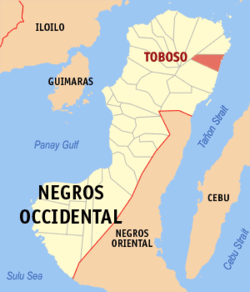Toboso, Negros Occidental
| Toboso | |
|---|---|
| Municipality | |
 Map of Negros Occidental with Toboso highlighted | |
.svg.png) Toboso Location within the Philippines | |
| Coordinates: 10°43′N 123°31′E / 10.717°N 123.517°ECoordinates: 10°43′N 123°31′E / 10.717°N 123.517°E | |
| Country | Philippines |
| Region | Negros Island Region (NIR) |
| Province | Negros Occidental |
| Congr. district | 1st district of Negros Occidental |
| Barangays | 9 |
| Government[1] | |
| • Mayor | Richard M. Jaojoco |
| Area[2] | |
| • Total | 117.33 km2 (45.30 sq mi) |
| Population (2015)[3] | |
| • Total | 42,114 |
| • Density | 360/km2 (930/sq mi) |
| Time zone | PST (UTC+8) |
| ZIP code | 6125 |
| Dialing code | 34 |
| Languages | Cebuano, Hiligaynon (Ilonggo), Filipino, English |
Toboso is a third class municipality in the province of Negros Occidental, Philippines. According to the 2010 census, it has a population of 41,658 people.[3] The prominent families who have ruled this town are the Bedonia, De la Cruz, Baynosa and Valencia. The current mayor is Richard M. Jaojoco.
The word "Toboso" was mentioned by Spanish Explorer to be a group of early American Indians living in Texas and Monterey, Mexico. Probably, Spanish Colonizer in the Philippines named this Town. Philippine history books also mentioned Spanish Colonizers naming Filipinos as "Indio" (East Indies, Indies, or Indians).
Economy
Economic progress in Toboso is very slow due to the limited number of business establishments. It is commonly called the "poorest municipality" in Negros Occidental. Since its municipality recognition on July 1, 1948, the town struggled to be at par with its neighboring cities like Escalante, Sagay, San Carlos and the town of Calatrava.[4]
Economy depends on sugarcane plantation, farming (livestocks and poultry/game fowl) and fishing. Inhabitants often find work in neighboring provinces (engage in shipbuilding). Others worked as Overseas Filipino Workers, others engage in handicraft business. Some choose food preparations and forming of local, small businesses.
The town is generally peaceful with friendly inhabitants. A townhouse is situated in barangay Poblacion and is accessible by land and smaller boats for sea travel.
The inhabitants speak two languages: Ilonggo and Cebuano.
Barangays
Toboso is politically subdivided into 9 barangays.[2]
- Bandila
- Bug-ang
- General Luna
- Magticol
- Poblacion
- Salamanca
- San Isidro
- San Jose
- Tabun-ac
Demographics
| Population census of Toboso | ||
|---|---|---|
| Year | Pop. | ±% p.a. |
| 1990 | 34,621 | — |
| 1995 | 38,623 | +2.07% |
| 2000 | 40,712 | +1.14% |
| 2007 | 41,358 | +0.22% |
| 2010 | 41,658 | +0.26% |
| 2015 | 42,114 | +0.21% |
| Source: National Statistics Office[3][5] | ||
References
- ↑ "Municipalities". Quezon City, Philippines: Department of the Interior and Local Government. Retrieved 8 March 2013.
- 1 2 "Province: Negros Occidental". PSGC Interactive. Makati City, Philippines: National Statistical Coordination Board. Retrieved 8 March 2013.
- 1 2 3 "Total Population by Province, City, Municipality and Barangay: as of May 1, 2010" (PDF). 2010 Census of Population and Housing. National Statistics Office. Retrieved 8 March 2013.
- ↑ Philippine National Statistics Office
- ↑ "Province of Negros Occidental". Municipality Population Data. LWUA Research Division. Retrieved 16 August 2013.
External links
- Philippine Standard Geographic Code
- Philippine Census Information
- Local Governance Performance Management System
 |
Escalante |  | ||
| Sagay | |
Tañon Strait | ||
| ||||
| | ||||
| Calatrava |